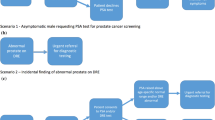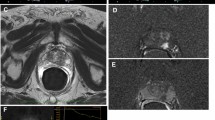Abstract
Purpose
To evaluate the feasibility of hexaminolevulinate (HAL) for the photodynamic detection of cancer cells in voided urine.
Methods
This study included 50 patients with bladder cancer that was confirmed histologically after transurethral resection (bladder cancer group) and 50 outpatients without a history of urothelial carcinoma or cancer-related findings (no malignancy group). One third of the voided urine samples were incubated with aminolevulinic acid (ALA-treated samples), one third were incubated with HAL (HAL-treated samples), and the remaining samples were incubated without treatment (untreated samples). For detecting cellular protoporphyrin IX levels, the intensity of the samples at the excitation wavelength of 405 nm was measured using a spectrophotometer. The difference between the intensity of the ALA-treated or HAL-treated samples and the untreated samples at 635 nm was calculated.
Results
HAL-induced fluorescence cytology (HFC) showed that the difference was significantly higher in patients with high-grade tumors than in those with low-grade tumors (p = 0.0003) and the difference was significantly higher in patients with low-grade tumors than in those without a history of urothelial carcinoma or cancer-related findings (p = 0.021). The areas under the receiver operating characteristic curves of ALA-induced fluorescence cytology (AFC) and HFC were 0.77 and 0.81, respectively. The AUC of HFC was significantly higher than that of AFC (p < 0.0001). The overall sensitivity values for conventional cytology, AFC, and HFC were 49, 74, and 74%, respectively. The overall specificity values for AFC and HFC were 70 and 94%, respectively.
Conclusions
Spectrophotometric photodynamic detection involving extracorporeal treatment with HAL for bladder cancer cells in voided urine showed high accuracy. This bladder cancer detection method is easy and cost-effective, and has the potential for clinical use.





Similar content being viewed by others
References
Badalament RA, Hermansen DK, Kimmel M et al (1987) The sensitivity of bladder wash flow cytometry, bladder wash cytology, and voided cytology in the detection of bladder carcinoma. Cancer 60:1423–1427
Caraway NP, Khanna A, Fernandez RL et al (2010) Fluorescence in situ hybridization for detecting urothelial carcinoma: a clinicopathologic study. Cancer Cytopathol 118:259–268
Chihara Y, Kanai Y, Fujimoto H et al (2013) Diagnostic markers of urothelial cancer based on DNA methylation analysis. BMC Cancer 13:275. doi:10.1186/1471-2407-13-275
Chung CW, Kim CH, Lee HM et al (2013) Aminolevulinic acid derivatives-based photodynamic therapy in human intra- and extrahepatic cholangiocarcinoma cells. Eur J Pharm Biopharm 85:503–510
Cunderlíková B, Wahlqvist R, Berner A et al (2007) Detection of urinary bladder cancer with flow cytometry and hexaminolevulinate in urine samples. Cytopathology 18:87–95
Datta S, Loh C, MacRobert A et al (1998) Quantitative studies of the kinetics of 5-aminolaevulinic acid-induced fluorescence in bladder transitional cell carcinoma. Br J Cancer 78:1113–1118
de Almeida EF, Abdalla TE, Arrym TP et al (2016) Plasma and urine DNA levels are related to microscopic hematuria in patients with bladder urothelial carcinoma. Clin Biochem 49:1274–1277
Fotion N, Convert N, Piffaretti JC et al (2008) Effects on gram-negative and gram-positive bacteria mediated by 5-aminolevulinic acid and 5-aminolevulinic acid derivatives. Antimicrob Agents Chemother 52:1366–1373
Frantzi M, van Kessel KE, Zwarthoff EC et al (2016) Development and validation of urine-based peptide biomarker panels for detecting bladder cancer in a multi-center study. Clin Cancer Res 22:4077–4086
Gaullier JM, Berg K, Peng Q et al (1997) Use of 5-aminolevulinic acid esters to improve photodynamic therapy on cells in culture. Cancer Res 57:1481–1486
Goodison S, Rosser CJ, Urquidi V (2013) Bladder cancer detection and monitoring: assessment of urine- and blood-based marker tests. Mol Diagn Ther 17:71–84
Goodson S, Ogawa O, Matsui Y et al (2016) A multiplex urinary immunoassay for bladder cancer detection: analysis of a Japanese cohort. J Transl Med 14:287. doi:10.1186/s12967-016-1043-1
Greene KL, Berry A, Konety BR (2006) Diagnostic utility of the ImmunoCyt/uCyt test in bladder cancer. Rev Urol 8:190–197
Gutièrrez Baños JL, del Henar Rebollo Rodrigo M, Antolı´n Jua´rez FM et al (2001) Usefulness of the BTA STAT test for the diagnosis of bladder cancer. Urology 57:685–689
Herr H, Donat SM (2016) Commentary: does asymptomatic bacteriuria reduce the risk of recurrence of non–muscle-invasive bladder tumors? Urology 98:1–3
Jichlinski P, Guillou L, Karlsen SJ et al (2003) Hexyl aminolevulinate fluorescence cystoscopy: new diagnostic tool for photodiagnosis of superficial bladder cancer a multicenter study. J Urol 170:226–229
Konety B, Lotan Y (2008) Urothelial bladder cancer: biomarkers for detection and screening. BJU Int 102(9b):1234–1241
Lokeshwar VB, Habuchi T, Grossman HB et al (2005) Bladder tumor markers beyond cytology: International Consensus Panel on bladder tumor markers. Urology 66:35–63
Metz CE, Herman BA, Roe CA (1998) Statistical comparison of two ROC-curve estimates obtained from partially-paired datasets. Med Decis Mak 18:110–121
Miyake M, Nakai Y, Anai S et al (2014) Diagnostic approach for cancer cells in urine sediments by 5-aminolevulinic acid-based photodynamic detection in bladder cancer. Cancer Sci 105:616–622
Nakai Y, Anai S, Onishi S et al (2015) Protoporphyrin IX induced by 5-aminolevulinic acid in bladder cancer cells in voided urine can be extracorporeally quantified using a spectrophotometer. Photodiagn Photodyn Ther 12:282–288
Nakai Y, Tatsumi Y, Miyake M et al (2016) Expression of ferrochelatase has a strong correlation in protoporphyrin IX accumulation with photodynamic detection of bladder cancer. Photodiagn Photodyn Ther 13:225–232
Nitzan Y, Salmon-Divon M, Shporen E et al (2004) ALA induced photodynamic effects on gram positive and negative bacteria. Photochem Photobiol Sci 3:430–435
Ponsky LE, Sharma S, Pandrangi L et al (2001) Screening and monitoring for bladder cancer: refining the use of NMP22. J Urol 166:75–78
Smith ZL, Guzzo TJ (2013) Urinary markers for bladder cancer. F1000Prime Rep 5:21. doi:10.12703/P5-21
Urquidi V, Netherton M, Gomes-Giacoia E et al (2016) Urinary mRNA biomarker panel for the detection of urothelial carcinoma. Oncotarget 7:38731–38740
van der Aa MN, Steyerberg EW, Sen EF et al (2008) Patients’ perceived burden of cystoscopic and urinary surveillance of bladder cancer: a randomized comparison. BJU Int 101:1106–1110
van Kessel KE, Beukers W et al (2017) Validation of a DNA methylation-mutation urine assay to select patients with hematuria for cystoscopy. J Urol 197:590–595
Author information
Authors and Affiliations
Corresponding author
Ethics declarations
Conflict of interest
The authors declare that they have no conflicts of interest.
Research involving human participants
The study protocol was in accordance with the provisions of the Declaration of Helsinki and was approved by the ethics committee of Nara Medical University.
Informed consent
All patients in the study period were offered to participate in this study, and those who provided written informed consent were enrolled.
Rights and permissions
About this article
Cite this article
Nakai, Y., Ozawa, T., Mizuno, F. et al. Spectrophotometric photodynamic detection involving extracorporeal treatment with hexaminolevulinate for bladder cancer cells in voided urine. J Cancer Res Clin Oncol 143, 2309–2316 (2017). https://doi.org/10.1007/s00432-017-2476-5
Received:
Accepted:
Published:
Issue Date:
DOI: https://doi.org/10.1007/s00432-017-2476-5




